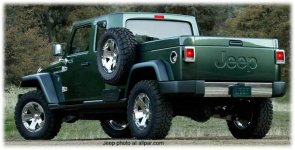For those of you who are interested in a the idea of a new Jeep pick-up truck, talk about one coming someday is still in the air but, I wouldn't hold your breath. Here's an article about it that was just published on AllPar today:
Are Jeep Pick-Ups Coming?
In a recent interview, Chrysler CEO Sergio Marchionne ruled out a compact Ram pickup, but he specifically did not rule out a compact Jeep pickup, saying that there was a special market for Jeeps.
One of the first questions that must be answered is what does the market really want? A true pickup, suitably styled to be identifiable as a Jeep and equipped to earn the required Trail-Rated badge? Or a regular Jeep converted to a pickup?
In a recent article, Allpar looked at the three types of recent Jeep pickups. We can probably rule out something like the Comanche, which was based on the original XJ Cherokee; it sold slowly (at an average of 23,806 sales per year). More important, the new Cherokee platform and architecture are unlikely to be amenable to a pickup variant; there really is no Chrysler or Jeep equivalent to the XJ now.
A pickup like the Comanche would compete in a niche market dominated by body-on-frame trucks like the Toyota Tacoma and Nissan Frontier that will soon see the addition of the revamped Chevrolet Colorado and GMC Canyon. An adaptation of the Cherokee would be more akin to the Honda Ridgeline, which has never lived up to Honda’s expectations and is being discontinued this year.
More likely for several reasons is a new Gladiator, similar to the 2006 Ram-based concept. Here’s why:
•Basing the truck on a short-bed, quad-cab Ram would save a great deal in engineering; it would essentially be a matter of interior and exterior styling, coupled with greater ground clearance and other altered suspension components, along with body changes to improve front and rear clearance, combined with heavy duty skid plates. (All Gladiators would be Trail Rated, since the base version is, well, a Ram.)
•The factories are already flexible.
•Using VM diesel engines would prevent Gladiator from destroying fuel-economy averages. Mileage would likely be in the range of 19 mpg City, 23 mpg Highway and 21 mpg Combined, slightly lower than ordinary Ram 4x4s. There could be an optional V6 as well. Sticking to V6 engines could free up some space to help approach angles and/or susension articulation (though this may not be possible due to factory limits or the position of the driveshaft).
•By limiting production to 30,000 per year, the company could reduce CAFE and Ram sales impact.
The downside would be cutting into Ram production, assuming Ram continues to be as popular as it is today, and having another gas-guzzler in the line; it would likely also cannibalize sales of Ram-branded trucks, especially the Power Wagon.
The pickup that most Jeepers seem to want, though, is the Scrambler, a Wrangler-based model. Engineering this would be relatively easy, thanks partly to work already done by AEV for their “Brute,” and partly because Wrangler remains body-on-frame; it could be done simultaneously with creating the 2018 Wrangler.
With the body-on-frame platform, it’s technically possible to have a true conventional pickup with separate cab and cargo body. However, there are valid reasons to discard that configuration, including the fact the market is unlikely to demand (and Jeep is unlikely to offer) an all-steel, enclosed cab.
The cheapest way to create a modern Scrambler would be to set up a civilian version of the J8 pickup, which was designed for military use. The question then is whether the bed is large enough, and whether large-scale production is even practical. Designed to be a patrol vehicle/weapons carrier with some cargo capacity, the J8 pickup has a small bed, decent payload capacity (about 3,000 pounds), but just 7,700 pounds of towing capacity.
Alternatively, the Wrangler Unlimited’s underpinnings would serve quite well for a pickup intended to be used as a go-anywhere lifestyle or activity vehicle as opposed to the multi-role vocational/recreational requirements of a conventional pickup.
There may be a market for such a pickup, again looking at 30,000 per year or so. The original CJ-8 Scrambler built from 1981 to 1986 never came close to that volume. Total production of the Scrambler came to 27,792 with the highest annual production rate of 8,355 units coming in the year it was introduced. Of course, if a new Jeep pickup could claim the percentage of Wrangler sales the Scrambler did in its three-year, pre-Comanche heyday, 30,000 sales per year would be quite feasible. n 1982, 20% of all CJs sold were Scramblers.
There’s one big catch with regards to the Jeep-based pickup: the plant that makes Wranglers can’t meet current demand, much less add a pickup to the mix. That’s probably the main reason the next Wrangler will likely have an independent suspension — it can be assembled as a package, off-site, and quickly installed at Toledo, increasing the factory’s capacity. (The “supplier park” design prevents the main factory’s footprint from being expanded).
What’s more, there’s no way Chrysler will invest the development money on a model that’s due to be replaced three years from now. Any Jeep Wrangler-based pickup will have to wait for the redesign in calendar-year 2017. Perhaps by then, it will have been planned as part of the line.
See the whole article on AllPar here:
http://www.allpar.com/news/index.php/2014/05/are-jeep-pickups-coming

